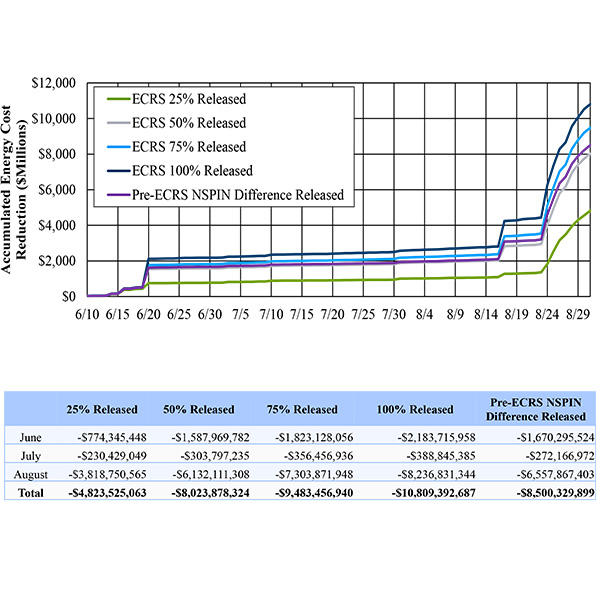
ERCOT’s Independent Market Monitor says the grid operator’s recent implementation of its first ancillary service in 20 years has nearly doubled the amount of required online reserves, resulting in “enormous” increases in market costs and shortage pricing when the market is long.
Carrie Bivens, the IMM’s vice president, told stakeholders Friday that procuring and deploying the ISO’s newest ancillary service (AS), ERCOT contingency reserve service (ECRS), has reduced supply and liquidity in the day-ahead market and “significantly” raised demand for AS products. That has resulted in inefficient day-ahead AS price spikes, she said.
“We’re seeing a disconnect between the operational realities and the pricing outcomes,” she said during a Wholesale Market Working Group meeting. “It’s also causing reliability issues, in our opinion, by increasing the challenges with managing congestion because fewer megawatts are available for scheduled dispatch to manage congestion … we’ve seen that on a few days you’re seeing a huge increase in market costs.”
AS services have incurred $1.56 billion in costs this year through August, Bivens said. ECRS, which began June 10, is responsible for almost 39% of those costs, or just over $608 million.
She said while the costs are substantial, they are much lower than the effects of removing the additional reserves from real-time market dispatch. Increasing online reserve procurements with ECRS “likely” raised the real-time market’s energy value by $8-10 billion in three months, Bivens said.
“Price spikes in the day-ahead market are not necessarily reflective of the underlying conditions,” she said. “The huge costs that we are really keying in on are the ones from [the] real-time market by removing those reserves. Taking megawatts that would have been available for energy dispatch and making them unavailable is reducing the supply available … that is causing this increase in real time energy prices, even though we have tons of reserves.”
The new AS is economically dispatched within 10 minutes of deployment, using capacity that can be sustained at a specified level for two consecutive hours. ECRS essentially meets the same reliability requirements that previously were met solely by responsive reserve service (RRS), the IMM pointed out.
ECRS has resulted in a 2,500-MW increase in online reserve procurements, moving the MWs behind the high ancillary services limit (HASL). Bivens says that has resulted in artificial pricing shortages when total reserve levels are high and a negative effect on congestion management, as more MWs needed to address congestion are reserved for ECRS or RRS.
She said the artificial tightness is “episodically mitigated” by the operators’ deployments, which interferes with day-ahead market decisions, whether to self-commit resources in real time and resource offers — all of which are based on expectations of real-time prices.
IMM staff arrived at the $8-10 billion figure by simulating the real-time energy market with reconstructed offer curves for lower ECRS procurements. Their analysis cleared the input MW quantity at the generation requirement’s original SCED execution. Once a baseline scenario was done, staff modeled incremental 25% releases of ECRS in subsequent scenarios and calculated energy cost reductions.
Real-time ECRS deployments were maintained so that none of its additional capacity was released if deployments exceeded the release percentage. The simulation did not model congestion, ramp limitations, controllable load resources’ dispatch or the power balance penalty curve.
“We wanted to show is this a small problem or is this a big problem?” Bivens said. “This is an order of magnitude type of analysis and what this is showing is that indeed it is a large problem.”
Jeff Billo, ERCOT’s director of operations planning, pushed back against Bivens’ presentation and the IMM’s call for a holistic review of ECRS, among other recommendations. He acknowledged inefficiencies and additional market costs but said ERCOT is getting the reliability it needs.
“When I look at the data that was presented, I don’t see anything that backs up those recommendations other than ancillary services are really expensive or they’re causing outcomes in the market that are really expensive. I don’t see any data showing that we’re getting more than we actually need,” he said. “I also don’t agree with the term artificial scarcity because this is a reserve product that we are buying, so it is meant to be held in reserve. It’s not artificial, it is on purpose. We are reasonably reserving megawatts that we may need for various conditions that may occur on the system.”
“I think we just want to make sure that you’re buying what you need to be reliable, and no more than that,” Bivens responded. “And also, I think we need to ask the question of the ECRS that we got this summer, ‘Was it worth $10 billion?’ That’s something that I think I would ask people to think about.
“A lot of these megawatts, particularly during the summer, they’re going to be online anyway,” she added. “All you’re doing, and why I’m calling it ‘artificial scarcity,’ is you’re taking megawatts that would have been online for energy and putting them behind the HASL. And that’s what’s causing the cost increase. It’s not that we’re getting more megawatts. It’s just how we’re treating them.”
The IMM recommends ERCOT reduce the ECRS’ two-hour duration requirement to a single hour to encourage more storage participation. Its other recommendations include:
-
- Reducing ECRS’ frequency recovery MW procurement;
- Removing the 2,800-MW floor on RRS;
- Changing the non-spin error requirement from six hours ahead to three; and
- Using 10-minute ahead net load errors for ECRS methodology.
The recommendations are based on the 2023 AS methodology and will be updated when ERCOT staff publishes its 2024 for the services, Bivens said.
The Texas grid operator launched ECRS in June. It was the first daily-procured ancillary service introduced to the market in more than 20 years.
ECRS’ development began as a protocol change, approved in 2019, designed to address forecasting errors from the increased penetration of renewable resources or to replace deployed reserves. The change also modified responsive reserve service to be primarily a frequency response.




